Poland 2000 "Prehistoric Animals: Dinosaurs"
| <prev | back to index | next> |
| Issue Date | 24.03.2000 |
| ID | Michel: 3811-3816, BL. 139 Scott: 3503-3508, 2508a; Stanley Gibbons: 3843-3848, MS3848a; Yvert: 3586-3591, ; Category: pR |
| Design | Jacek Brodowski |
| Stamps in set | 6 |
| Value |
70 gr - Saurolophus 70 gr - Gallimimus 80 gr - Saichania 80 gr - Protoceratops 1.55 zl - Prenocephale 1.55 zl - Velociraptor |
| Emission/Type | commemorative |
| Places of issue | Warsaw |
| Size (width x height) | 51 mm x 31.25 mm |
| Layout | Sheets of 20 stamps, Mini-Sheet of 6. |
| Products | FDC x 3, MS x 1 |
| Paper | security, fluorescent |
| Perforation | 11 x 11.5 |
| Print Technique | Offset, multicolor |
| Printed by | State Printing Works of Securities Warsaw (PWPW) |
| Quantity |
70 gr - 2.700.000 each, 70 gr - 2.700.000 each, 1.55 zl - 1.700,000 each. Mini-Sheet: 30.000. |
| Issuing Authority | Poczta Polska |
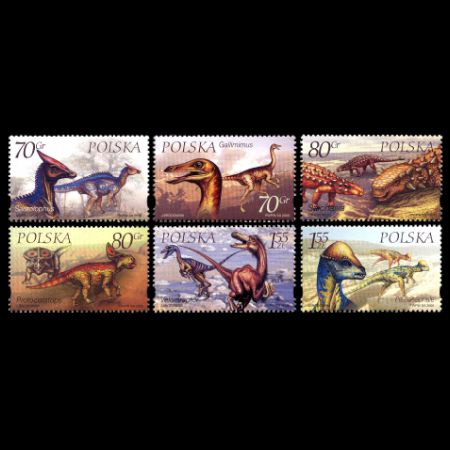
On March 24th, 2000, the Polish Post Authority issued the set six stamps "Prehistoric Animals - Dinosaurs".
These stamps depict reconstructions of dinosaurs, whose skeletons were discovered in the Gobi Desert by Polish-Mongolian Paleontological Expeditions between the years 1963 and 1971.
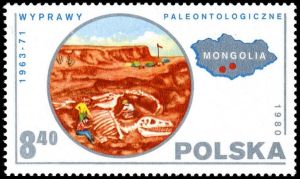 |
| Excavation of Tarbosaur bataar fossil on stamp of Poland 1980 MiNr.: , Scott: |
One of the stamps from Polish expedition set, issued in 1980 shows excavation of a dinosaur, perhaps Tarbosaur bataar , by Polish paleontologists in the Gobi Desert.
Some details about these expeditions can be found in the archive of PALAEONTOLOGIA POLONICA. This web site is a monograph series published by the Institute of Palaeobiology of the Polish Academy of Sciences. Its format, established in 1929 by Roman Kozlowski (depicted on Polish stamp in 1990), remains virtually unchanged
The text below is a quote of the text published by Pocta Polska in 2000. This article doesn't exist on the Internet anymore.
All of these animals, depicted on these stamps, lived at the end of the Mesozoic Era, in the late Cretaceous Period, about 70 millions years ago. Their skeletons can be seen in the Museum of Evolution in Warsaw (PKiN), and the live-size reconstructions in the Silesian Zoological Garden in Chorzow.
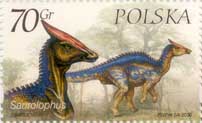
|
| Saurolophus on stamp of Poland 2000, MiNr.: 3811, Scott: 3503. |
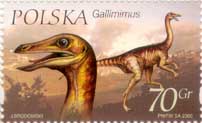
|
| Gallimimus on stamp of Poland 2000, MiNr.: 3812, Scott: 3504. |
Gallimimus - the biggest (ca. 5 m length) representative of dinosaurs similar to ostrich: no teeth, long legs, and long necks, predatory; Ornithischians. It was the most numerous dinosaur living in the Jurassic Park. It was described and named by Polish scientists: Professor Ewa Roniewicz and Halszka Osmólska from the Paleobiology Department at the Polish Academy of Sciences (PAN), at the cooperation with the Mongolian paleontologist, Rinczen Barsbolden.
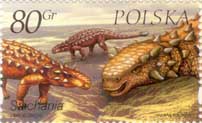
|
| Saichania on stamp of Poland 2000, MiNr.: 3813, Scott: 3505. |
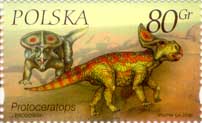
|
| Protoceratops on stamp of Poland 2000, MiNr.: 3814, Scott: 3506. |
Protoceratops - very popular in numerous uncovered rocks from the Cretaceous period in Mongolia and China. A primitive horny dinosaur resembling its bigger cousins (e.g. Triceratops) with the bony collar at the rear of the head and a curvy beak. The four-leg plant eater was 2 m long. It lived in herds in dry, desert places.
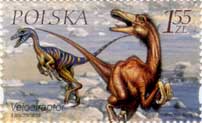
|
| Prenocephale on stamp of Poland 2000, MiNr.: 3815, Scott: 3507. |
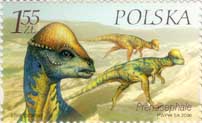
|
| Velociraptor on stamp of Poland 2000, MiNr.: 3816, Scott: 3508. |
Velociraptor - known, e.g., from the film Jurassic Park. An agile predatory dinosaur from the group of Dromaeosaurs, of the body length of almost 2m, it was a close relative of birds. Velociraptor attached its victim with characteristic claws in its legs.
Products and associated philatelic items
| Mini-Sheet | FDC | First-Day-of-Issue Postmark |
 |
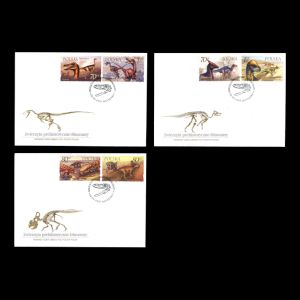 |
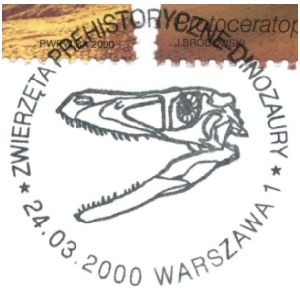 |
| The cachets of FDC covers shows skeletons of Saurolophus, Protoceratops and Velociraptor. | Skull of Velociraptor depicted on the commemorative postmark.
|
|
| Stamp Sheets | ||
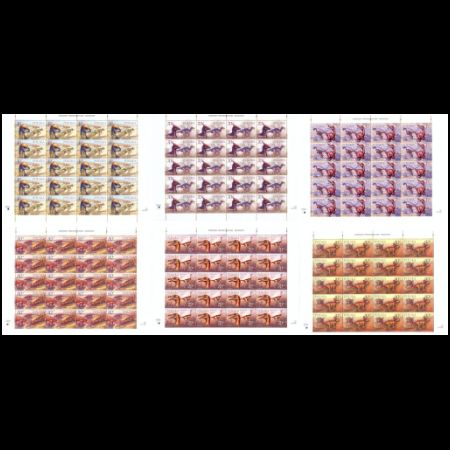 |
|
|
| Examples of circulated covers | ||
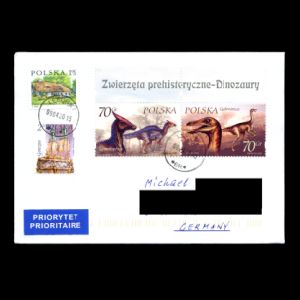 |
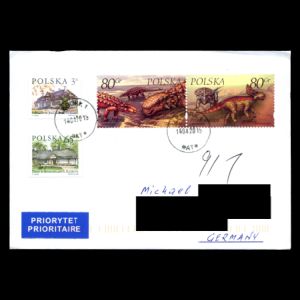 |
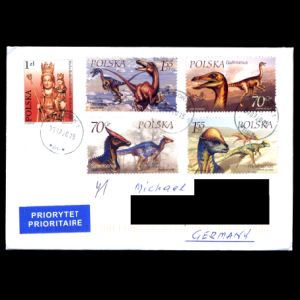 |

|
References
- Technical details:
- Poczta Polska (the article does not exist anymore)
- colnect
Acknowledgements
Many thanks to Dr. Peter Voice from Department of Geological and Environmental Sciences, Western Michigan University, for reviewing the draft page and his very valuable comments.| <prev | back to index | next> |